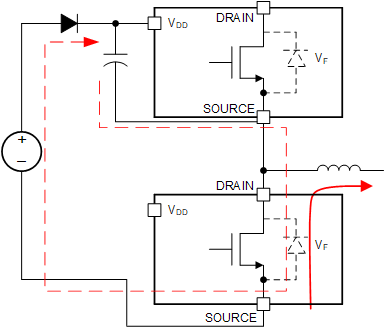SNOSDF3A November 2022 – May 2024 LMG3522R030 , LMG3526R030
PRODUCTION DATA
- 1
- 1 Features
- 2 Applications
- 3 Description
- 4 Pin Configuration and Functions
- 5 Specifications
- 6 Parameter Measurement Information
-
7 Detailed Description
- 7.1 Overview
- 7.2 Functional Block Diagram
- 7.3
Feature Description
- 7.3.1 GaN FET Operation Definitions
- 7.3.2 Direct-Drive GaN Architecture
- 7.3.3 Drain-Source Voltage Capability
- 7.3.4 Internal Buck-Boost DC-DC Converter
- 7.3.5 VDD Bias Supply
- 7.3.6 Auxiliary LDO
- 7.3.7 Fault Protection
- 7.3.8 Drive-Strength Adjustment
- 7.3.9 Temperature-Sensing Output
- 7.3.10 Ideal-Diode Mode Operation
- 7.3.11 Zero-Voltage Detection (ZVD)
- 7.4 Start-Up Sequence
- 7.5 Device Functional Modes
- 8 Application and Implementation
- 9 Device and Documentation Support
- 10Revision History
- 11Mechanical, Packaging, and Orderable Information
Package Options
Mechanical Data (Package|Pins)
- RQS|52
Thermal pad, mechanical data (Package|Pins)
- RQS|52
Orderable Information
8.4.2.2 Managing the Bootstrap Voltage
In a synchronous buck or other converter where the low-side switch occasionally operates in third-quadrant, the bootstrap supply charges through a path that includes the third-quadrant voltage drop of the low-side LMG352xR030 during the dead time as shown in Figure 8-7. This third-quadrant drop can be large, which can over-charge the bootstrap supply in certain conditions. The VDD supply of LMG352xR030 must be kept below 18V.
 Figure 8-7 Charging Path for Bootstrap Diode
Figure 8-7 Charging Path for Bootstrap DiodeAs shown in Figure 8-8, the recommended bootstrap supply includes a bootstrap diode, a series resistor, and a 16V TVS or Zener diode in parallel with the VDD bypass capacitor to prevent damaging the high-side LMG352xR030. The series resistor limits the charging current at start-up and when the low-side device is operating in third-quadrant mode. This resistor must be selected to allow sufficient current to power the LMG352xR030 at the desired operating frequency. At 100kHz operation, TI recommends a value of approximately 2Ω. At higher frequencies, this resistor value must be reduced or the resistor omitted entirely to ensure sufficient supply current.
 Figure 8-8 Suggested Bootstrap Regulation Circuit
Figure 8-8 Suggested Bootstrap Regulation Circuit